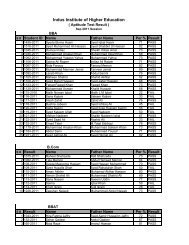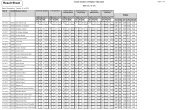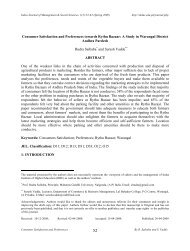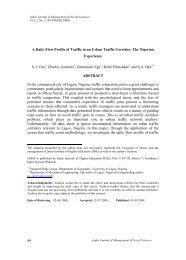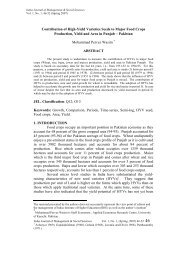9-4-Arif Zubair - FUUST-FUUST-Status of Noise Pollution
9-4-Arif Zubair - FUUST-FUUST-Status of Noise Pollution
9-4-Arif Zubair - FUUST-FUUST-Status of Noise Pollution
Create successful ePaper yourself
Turn your PDF publications into a flip-book with our unique Google optimized e-Paper software.
Indus Journal <strong>of</strong> Management & Social Sciences, 5(2):100-105 (Fall 2011)<br />
ideas.repec.org/s/iih/journl.html<br />
Karachi City, Pakistan, and found that levels <strong>of</strong> noise were generally higher during mornings and evenings<br />
for the reason that <strong>of</strong> the commuting pattern <strong>of</strong> Karachi inhabitants. Results <strong>of</strong> this study found the average<br />
value <strong>of</strong> noise levels to be over 66 dB, which possibly will cause serious annoyance according to the World<br />
Health Organization (WHO) outdoor noise guidelines. Maximum peak noise was over 101 dB, which is close<br />
to 110 dB, the level that can cause possible hearing impairment according to the WHO guidelines. It shows<br />
that noise pollution is not an environmental problem set aside for developed countries, but occurs in<br />
developing countries as well. For this cause, steps are required to reduce noise levels caused by road traffic.<br />
The major factors, which contributed towards all forms <strong>of</strong> pollution in Karachi, are mainly population,<br />
industries, seaport, road, rail and air transport, neighborhood and recreational noise. As noise <strong>Pollution</strong> is<br />
unwanted sound that introduce into our daily activities. No one on earth can escape the sounds <strong>of</strong> noise, an<br />
unwanted disturbing sound that causes a nuisance in the eye <strong>of</strong> the beholder. Same problem exist in<br />
developing and developed countries, which are supported from Duerden (1970), Julii, Jones, Batman and<br />
Lovett (1985), Khoshoo (1991) Rajvanshy and Goel (1987).<br />
These conditions forced us to undertake this study and for that, Gulshan-e-Iqbal is selected for the same<br />
considering its prime location, area and population. Attempt was made to set standards for some <strong>of</strong> the most<br />
major sources <strong>of</strong> noise, which <strong>of</strong>ten are unable to monitor. The following areas required to be investigated in<br />
some detail, transportation, natural-effects, sleeps, hearing damage and physiological effects.<br />
2. EXPERIMENTAL<br />
2.1 Study Area<br />
Gulshan-e-Iqbal town is largest town <strong>of</strong> Karachi. It is located in the center <strong>of</strong> the city covering an area <strong>of</strong> 26<br />
sq. km with 13 union council. The population <strong>of</strong> the town is approximately 1.5 million as per last census (see<br />
Fig.1). Two intersection i.e. Gulshan-e-Iqbal crossing and NIPA crossing <strong>of</strong> Gulshan-e-Iqbal town were focal<br />
point <strong>of</strong> our study as these two are intersection point <strong>of</strong> Rashid Minhas road main links to other part <strong>of</strong> the<br />
city. <strong>Noise</strong> intensity was measured between 3.0 pm to 5.0 pm by dB meters at EPA distance standard (for<br />
noise level) 75 m. Following observation ware recorded shown in Table 1 - 4. To study the whole area at<br />
particular intersection we have established the various points (shown Fig 2-3) based on the importance <strong>of</strong><br />
traffic flow endangering the domestic population.<br />
<strong>Status</strong> <strong>of</strong> <strong>Noise</strong> <strong>Pollution</strong>: A Case Study <strong>of</strong> Gulshan-E-Iqbal Town…<br />
101<br />
By <strong>Arif</strong> <strong>Zubair</strong> and Seema Naz Siddiqui



